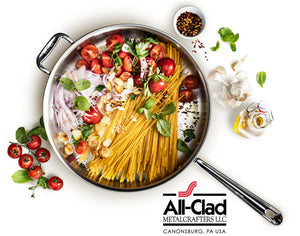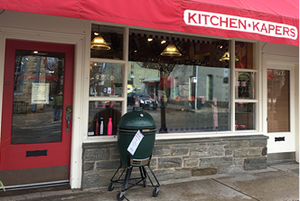
Steady sales prove that home cooks of all levels prefer to have at least a couple pieces of nonstick cookware in their kitchens.
And why not? Today's PTFE and Ceramic-based coatings offer slick, reliable performance so omelets roll out beautifully, pancakes flip without a fight and seared ahi tuna turns with ease. Plus, it's so much easier to clean.
But lots of cooks don't realize that if they treat their non-stick pans like any other old cookware, those easy-release properties they love so much will slip away well before their time. So if you want to preserve your cookware's non-stick performance and get the most out of your purchase, you'll need to follow some simple, but very important rules...
Dishwashing will destroy non-stick surfaces-
Sure, it may not be apparent the first, or third, or even 20th cycle. But every time you wash PTFE or ceramic surfaces in the dishwasher, it becomes slightly paler, slightly less smooth and slightly less effective. Eventually the non-stick surface becomes a dull-looking version of the pan it once was, and cooks with marginal non-stick performance. Don't underestimate the corrosiveness of dishwasher detergent and water jet force; it's brutal in there.
Mild soap, don't scrub-
So you know that your pans should be hand washed. Just don't reach for the harsh detergents or citrus based cleaners. Non-stick shouldn't need scrubbing, after all. Mild soap and a wet sponge or cloth should quickly wipe your nonstick surfaces clean. So what to do with a pan splattered and splotched with stubborn stains? Follow this link to learn The Best Ways to Clean Your Cookware for the type of nonstick you use.
Don't trust metal utensils-
We know the manufacturer might say it's okay, but listen. If we bet you 1000 bucks that you couldn't scratch a PTFE or ceramic surface non-stick pan, and your choice of weapons was a steel fork or a soft silicone spatula, which would you pick? The point is, if it can be scratched, metal utensils will be the ones to do it. And while certain non-stick lines such as Swiss Diamond, Scanpan and Ballarini boast impressively durable designs, why subject them to sharp metal edges when there are so many great and affordable utensils made from high-temp silicone, hard nylon and natural wood?
Avoid High Heat!-
To help prevent overheating, invest in quality cookware. One of the reasons premium brands cost more is that they construct cookware with thicker cooking surfaces that diffuse heat more evenly. And that means less potential for hot-spots, which gives you more control over the heat of the pan. But remember, even the best nonstick surfaces don't like high temperatures. They work best on low or medium heat. In fact, PTFE cookware shouldn't be heated above 350° F, so don't put it under the broiler, unless you want to ruin your pan's non-stick surface. Also, the quickest way to destroy the slick surface of a ceramic nonstick is to overheat fat onto its surface. This will effectively undo the nonstick properties of the pan, so keep the heat around medium, and be sure to thoroughly wash cooking fats from the surface after use.
Put the cooking spray away-
This one surprises a lot of people. If you like to use aerosol cooking sprays on nonstick to create an extra slick pan, DON'T! These sprays actually create a sticky build-up that's a nightmare to wash off. Over time, this coating blocks the non-stick properties of the pan, and your meals start to cling to your cookware.
But do use cooking oil-
No matter what you've heard, non-stick doesn't mean oil-free. Though aerosol sprays are not your pan's friend, natural cooking oils are. You don't need to use a lot, just a light coating of olive oil, canola oil, or butter and your frittatas, crepes, and breakfast fajitas will slide out of the pan and onto the plate without a fuss. And just as important, that little bit of cooking oil helps the pan surface disperse heat faster, so it remains nonstick longer.
Scratched pans are broken pans-
That trusty non-stick pan that you use every day for scrambled eggs and weekend pancake breakfasts will eventually fall prey to excessive of wear and tear. If you find that your pans are heavily scratched, don't use them. The non-stick layer probably won't perform properly and, more importantly, chemicals from the pan may leach into your food. Your pans can get scratched from use- but also typically from improper storage! That's why you have to have a gameplan for storage. Take a look inside your kitchen cabinets some time. Are they filled with hastily stacked pans all jumbled together? Then it's likely you've got some pans with a fair amount of scratches, scrapes and dings. The safest way to store and display your pans is on hanging pot racks. If that's not an option or if space constraints make it necessary to stack pans, use felt pan protectors, old dish towels, rags or even paper towels in between the pans.
Non-stick pans will never be heirloom pieces-
As long as you know how to take care of your PTFE and ceramic coated cookware, you can preserve the non-stick coating and keep the pans in good condition for some time. But this type of pan will never be as durable as cast iron, carbon steel, or stainless steel. Expect to replace your non-stick pans every 4-8 years, depending on initial quality and use. Bargain-priced pans will likely need to be replaced much sooner.
Interested in an affordable nonstick option that you can use for decades? Read on to learn why "Carbon Steel" is how the pros say "nonstick"!




